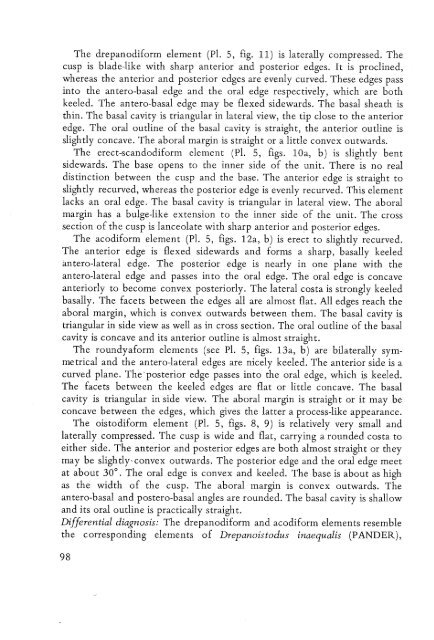UTRECHT MICROPALEONTOLOGICAL BUllETINS
UTRECHT MICROPALEONTOLOGICAL BUllETINS
UTRECHT MICROPALEONTOLOGICAL BUllETINS
You also want an ePaper? Increase the reach of your titles
YUMPU automatically turns print PDFs into web optimized ePapers that Google loves.
The drepanodiform element (PI. 5, fig. 11) is laterally compressed. The<br />
cusp is blade-like with sharp anterior and posterior edges. It is proclined,<br />
whereas the anterior and posterior edges are evenly curved. These edges pass<br />
into the antero-basal edge and the oral edge respectively, which are both<br />
keeled. The antero-basal edge may be flexed sidewards. The basal sheath is<br />
thin. The basal cavity is triangular in lateral view, the tip close to the anterior<br />
edge. The oral outline of the basal cavity is straight, the anterior outline is<br />
slightly concave. The aboral margin is straight or a little convex outwards.<br />
The erect-scandodiform element (PI. 5, figs. lOa, b) is slig~tly bent<br />
sidewards. The base opens to the inner side of the unit. There is no real<br />
distinction between the cusp and the base. The anterior edge is straight to<br />
slightly recurved, whereas the posterior edge is evenly recurved. This element<br />
lacks an oral edge. The basal cavity is triangular in lateral view. The aboral<br />
margin has a bulge-like extension to the inner side of the unit. The cross<br />
section of the cusp is lanceolate with sharp anterior and posterior edges.<br />
The acodiform element (PI. 5, figs. 12a, b) is erect to slightly recurved.<br />
The anterior edge is flexed sidewards and forms a sharp, basally keeled<br />
antero-lateral edge. The posterior edge is nearly in one plane with the<br />
antero-lateral edge and passes into the oral edge. The oral edge is concave<br />
anteriorly to become convex posteriorly. The lateral costa is strongly keeled<br />
basally. The facets between the edges all are almost flat. All edges reach the<br />
aboral margin, which is convex outwards between them. The basal cavity is<br />
triangular in side view as well as in cross section. The oral outline of the basal<br />
cavity is concave and its anterior outline is almost straight.<br />
The roundyaform elements (see PI. 5, figs. 13a, b) are bilaterally symmetrical<br />
and the antero-lateral edges are nicely keeled. The anterior side is a<br />
curved plane. The' posterior edge passes into the oral edge, which i,skeeled.<br />
The facets between the keeled edges are flat or little concave. The basal<br />
cavity is triangular in side view. The aboral margin is straigh t or it may be<br />
concave between the edges, which gives the latter a process-like appearance.<br />
The oistodiform element (PI. 5, figs. 8, 9) is relatively very small and<br />
laterally compressed. The cusp is wide and flat, carrying a rounded costa to<br />
either side. The anterior and posterior edges are both almost straight or they<br />
may be slightly-convex outwards. The posterior edge and the oral edge meet<br />
at about 30°. The oral edge is convex and keeled. The base is about as high<br />
as the width of the cusp. The aboral margin is convex outwards. The<br />
antero-basal and postero-basal angles are rounded. The basal cavity is shallow<br />
and its oral outline is practically straight.<br />
Differential diagnosis: The drepanodiform and acodiform elements resemble<br />
the corresponding elements of Drepanoistodus inaequalis (PANDER),
















